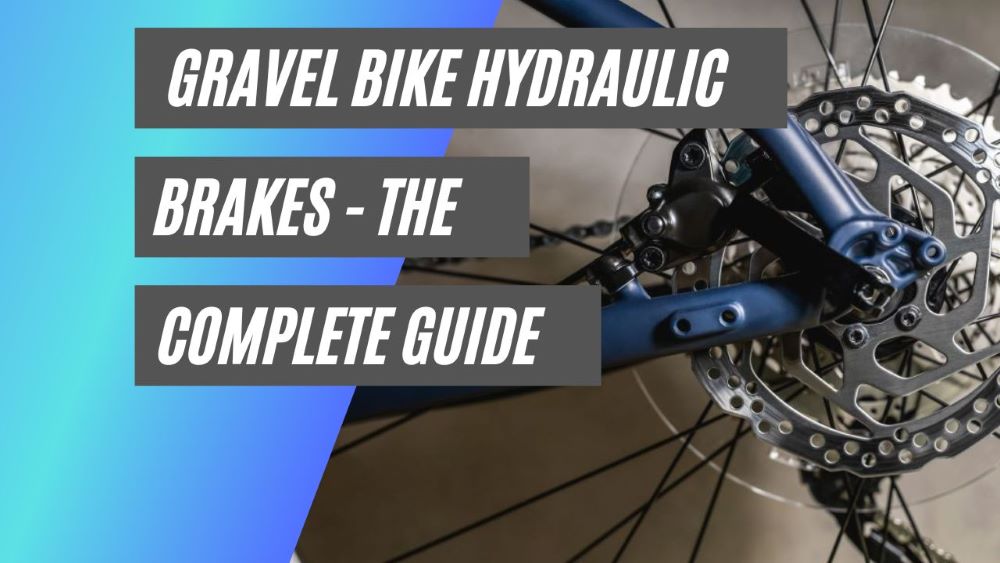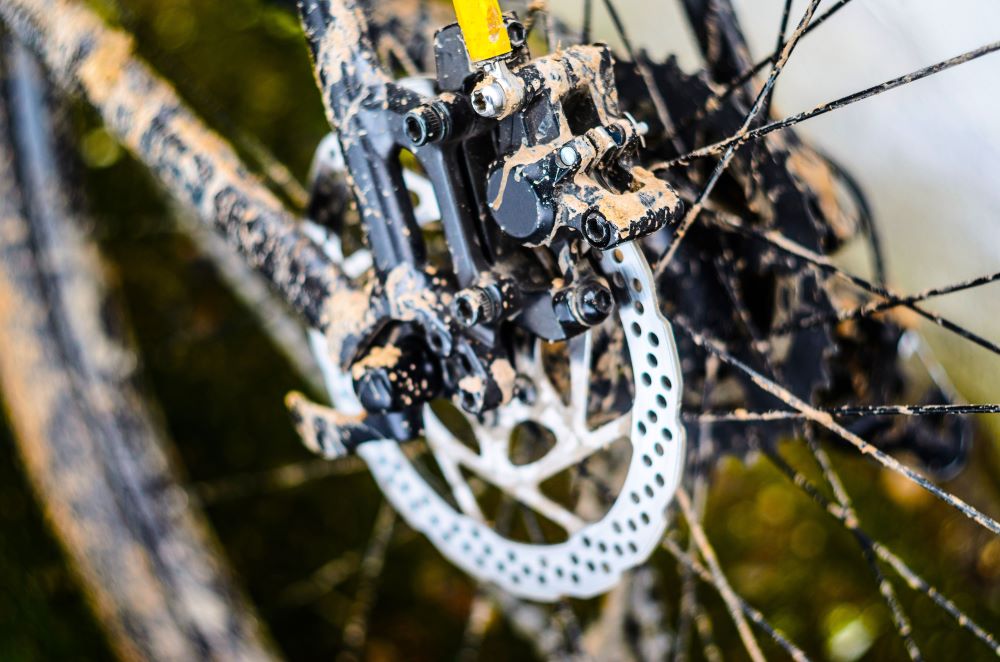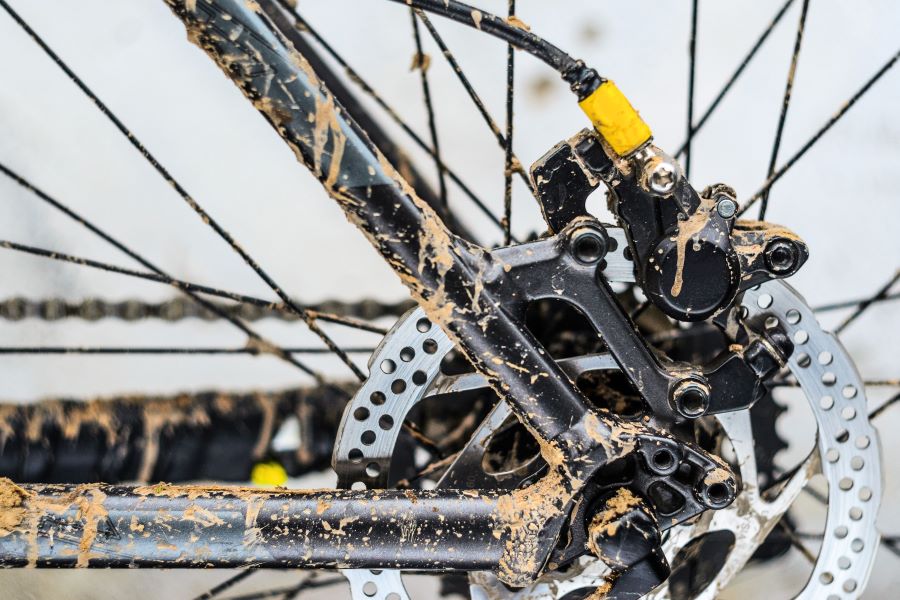This post may contain affiliate links. If you click an affiliate link and make a purchase, I may earn a commission. Also, as an Amazon Associate, I earn from qualifying purchases.--
Rim brakes are tried and tested, and workly perfectly well for all types of bikes. However, many people who try disk brakes, say it’s a night and day difference. There are two types of disk brakes, hydraulic and cable disk brakes.
Today, I will cover everything there is to know about hydraulic brakes on a gravel bike.
Whether you’re brand new to cycling or are very experienced, this article will give you facts and tips that will help you decide if hydraulic brakes are best for your gravel bike.

Are Hydraulic Brakes the Best on a Gravel Bike?
Hydraulic brakes use fluid pressure to brake, rather than mechanical force. All other bike brakes use mechanical force with the help of leverage to brake.
For gravel brakes specifically, here’s whether hydraulic brakes are the best.
In general, hydraulic brakes are the best on a gravel bike. They provide the most braking power for the least amount of force. They also enable you to come to a complete stop the fastest. One issue is they are harder to repair than cable disk brakes.
Independent tests have been conducted to compare the stopping power of each of the different brake types. Here’s a table that shows how hydraulic brakes compare to other types of brakes based on the distance it takes to stop at the same speed.
| Type of brakes | Average stopping distance |
| Stock setup | 47.6 feet (14.5 m) |
| More expensive rotors | 47.1 feet (14.3 m) |
| Metallic pads | 45.4 feet (13.8 m) |
| Hydraulic brakes | 40.1 feet (12.2 m) |
| Hydraulic brakes with more expensive – rotors front brake only | 44.5 feet (13.5 m) |
| Hydraulic brakes with low-end rotors – rotors front brake only | 43.6 feet (13.3 m) |
| Cable brakes, smaller rotor (160 mm) – front brake only | 58.8 feet (18 m) |
| Cable brakes, larger rotor (180 mm) – front brake only | 46.5 feet (14.2 m) |
Key points about each type of brake used in the tests:
| Type of brakes | Key info about each |
| Stock setup | Axiom cheap rotors |
| More expensive rotors | Shimano rotors, $100 more expensive |
| Metallic pads | Required less braking power |
| Hydraulic brakes | Can’t use metallic pads, but can brake with one finger without straining. |
| Hydraulic brakes with more expensive – rotors front brake only | – |
| Hydraulic brakes with low-end rotors – rotors front brake only | Shows that at the low end the cost of rotors that are under $100 doesn’t make much difference. |
| Cable brakes, smaller rotor (160 mm) – front brake only | – |
| Cable brakes, larger rotor (180 mm) – front brake only | A significant difference in braking power to smaller rotors. |
(source: Trail features video)
The hydraulic brakes used in these experiments were under $100. So, are very cheap. With that said, it’s well known that hydraulic brakes are very difficult to install.
Especially in the hydraulic lines are interior, and run through the frame of your bike. But, it can still be worth it, if you have it done at a bike shop where they have lots of experience in doing it.
The main stand-out results from these experiments showed that:
- Hydraulic brakes have far greater stopping power than cable brakes.
- At the low-end price points, cheaper or more expensive rotors only make a marginal difference.
- Larger rotors were the best at increasing stopping distance apart from upgrading to hydraulic brakes.
Here’s a table that shows how the different braking setups compare based on percentages. The percentages are compared to the stock setup.
| Type of brakes | Percentage |
| Low-end rotors, cable brakes (stock setup) | – |
| More expensive rotors, cable brakes | 2% faster at stopping |
| Metallic pads | 5% faster at stopping than the stock setup |
| Hydraulic brakes | 16% faster at stopping than the stock setup |
| 160mm rotor compare to 180mm rotor | 180 mm rotor is 26% faster at stopping. |
Not only, were the hydraulic brakes 16% faster at stopping. But, they also required far less force to brake.
It’s important to note that when braking most of the braking power comes from the front wheel. The reason is as you brake your momentum is coming forward, and most of the force is concentrated on the front wheel.
Some estimates are that 70% of your braking power comes from the front wheel. Because larger rotors offer a good bang for the buck in stopping power – about 26% more braking power when going from 160mm to 180 mm rotors – it makes the most sense to get larger rotors only on the front tire.
That is if you’re trying to keep your costs down.

Don’t exceed the recommended rotor size
On the front tire, it’s usually possible to put almost any sized rotor. Because a bigger-sized rotor provides a very good bang for the buck in terms of stopping power it can be tempting to use a larger-sized rotor.
But, each tire size can only handle a certain-sized rotor. If the rotor is too big for the tire it can cause a failure. And, when riding at high speeds, it can cause a serious accident. Therefore, before putting a larger rotor double-check with a bike shop, or the spec sheet for your tire to see what the maximum rotor size is.
Cons of using hydraulic brakes on a gravel bike
Hydraulic brakes on a gravel bike have 2 main advantages over cable disk brakes, and rim brakes. These are:
- They are far easier to engage
- They provide much more braking power
However, there are some cons to hydraulic brakes for a gravel bike. These are:
- Hydraulic brakes have compatibility issues – they can’t interchange parts easily
- Cable disk brakes and rim brakes are easier to maintain
- Cable disk brakes and rim brakes are easy to adjust on the road/trail
- Cable disk brakes and rim brakes have a decent/sufficient amount of stopping power
- If something goes wrong in a remote area it’s hard to fix
Hydraulic brakes aren’t interchangeable with other hydraulic brake parts. Whereas, with rim brakes and cable disk brakes, it’s easy to swap out one part for another. And to source a compatible part.
Hydraulic brakes have more moving parts, and often the hydraulic lines run through the inside of the frame.
Also, if there is an issue with the lines it can often leak hydraulic fluid which is time-consuming to clean up.
This means it can be impossible to fix on the trail if you’re out somewhere remote, which is common with gravel riding. Therefore, you’ll be somewhat stranded.
Rim brakes and cable disk brakes also have more than enough braking power. All of these issues are significant. In my opinion, you should learn how to repair, and troubleshoot your hydraulic brakes before riding your bike somewhere remote. And keep a repair kit on hand.
An issue with your hydraulic brakes is fairly rare, so for the most part the pros outweigh the cons. Another consideration with trail riding is whether you should use road pedals or trail pedals.
I explained the pros and cons of both for trail riding in this article about road pedals on a gravel bike.

Can you install hydraulic brakes on a bike with rim brakes
It’s possible to convert a bike with rim brakes such as V brakes or cantilever brakes to disk brakes. These can be either hydraulic disk brakes or cable disk brakes. There are a few things to be aware of, they are:
- Not all bike frames have the mounts for hydraulic or cable disk brakes
- You will need new wheels in virtually all cases
- It’s quite a big job, especially if installing hydraulic disk brakes
There are special mounts on a bike frame that are required to install disk brakes. From now on I will just say disk brakes.
But, everything below refers to both hydraulic and cable disk brakes. Unless otherwise stated. The mounts are fairly easy to spot, as they don’t serve any purpose other than holding disk brakes. If in doubt they’re shown in the video below.
If you don’t have these mounts you can buy adapters. These can be purchased separately and will allow you to mount the disk brake mechanisms onto your bike frame.
As a general rule, the tires that you will have on a bike with rim brakes aren’t compatible with rim brakes, and you’ll need to replace them (source).
They won’t have mounts where you can screw on the rotors for your disk brakes. As you make know the rotors are what your disk brakes grab when they’re squeezed. They have a disk shape, hence the name disk brakes.
Other than that, know that it is a bit of a job to swap them out. You will need to remove your existing brakes, and then mount your new brakes on your bike frame.
And mount the rotors onto your tires. Here’s a video that shows the whole process from start to finish for converting V brakes to disk brakes.
Bear in mind that it’s a virtually identical process if you have cantilever brakes. The only difference is how you take off the cantilever brakes. It’s best to search for a video on how to do that. Installing hydraulic brakes are also a lot trickier to install than cable disk brakes.
There’s a really good video on the Park Tools youtube channel, for how to install hydraulic brakes. Refer to that after you’ve removed your existing V brakes or cantilever brakes.
Do Gravel Bikes Have Hydraulic Brakes?
Gravel bikes are much better suited for riding off-road. Recently, cable and hydraulic disk brakes have become more and more common. So, this is whether gravel bikes come with hydraulic disk brakes.
In general, it varies some have hydraulic brakes, whereas others do not. Gravel bikes are sold both with hydraulic and cable disk brakes. If you have hydraulic or cable disk brakes you can swap them out. But, it’s a lot of effort. So, it’s best to get the type of brakes you want to keep.
Either rim brakes, hydraulic disk brakes, or cable rim brakes.
Almost every bike shop will have each of the common different options. Or, you can buy the bike without any brakes, and choose the brakes you want separately.
Are Hydraulic Bike Brakes Better at Braking
Hydraulic brakes are newer technology compared to rim brakes. They also are more complex because they use fluid to make it easier to squeeze on the brake levers. But, are hydraulic brakes better at braking?
On average, hydraulic brakes at 16% faster at coming to a complete stop than cable disk brakes. Also, rim brakes take require about 2.5 meters more to come to a complete stop compared to disk brakes when traveling at 40 mph (64 km/h).
It’s best to feel out disk brakes before doing a hard stop. Braking very hard brings your weight forward a lot and the rear tire can lift off the ground. Rim brakes provide more than enough braking power. But, hydraulic brakes require less force.
Another advantage of disk brakes is that they work virtually the same in wet conditions and dry conditions. Whereas, rim brakes take longer to brake in wet conditions.
How Can You Tell if Your Bike Has Hydraulic Brakes
Hydraulic brakes and rim brakes both function in a similar way. Brake pads squeeze onto part of the wheel to slow it down. Hydraulic brakes don’t look too different from rim brakes, so here’s how you tell whether you have hydraulic brakes on your bike.
As a general rule, look for a flat metal disk about 6 inches (15.2 cm) in diameter located in the center of the front or rear wheel. If there is one your bike has disk brakes, not rim brakes. To know if you have hydraulic disk brakes refer to the info below.
The position of the brake pads will also tell you whether you have rim brakes or disk brakes. It can be identified by looking at what the brake pads do when you squeeze the brakes.
Rim brakes – which aren’t disk brakes – grab onto the rim of the tire. This is the metal part just inside the outer black rubber tire.
Disk brakes by comparison grab onto a disk that is located much closer to the very middle of the tire (source). If you’ve identified you have disk brakes and not rim brakes the next thing you need to check is what the brake pads do.
Cable disk brakes, have a wire that visibly shortens when you squeeze the brakes. Whereas, hydraulic disk brakes don’t have this cable.
Hydraulic disk brakes are an enclosed system, and the only part that moves is the brakes themselves, as the liquid is pushed into them.
On the other hand, the cable that’s visible on cable disk brakes is similar to that of V brakes and caliper brakes. When you squeeze the lever it shortens the wire in between both brack pads, to squeeze them together. You can see this working when you squeeze the brakes.
Here’s a really good video that shows how hydraulic brakes work:
